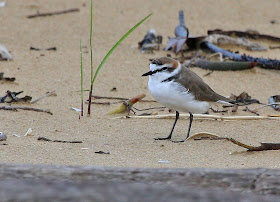However, conditions at Buntal were not ideal, illustrating the difficulties of counting a huge site where birds have a choice of roost sites. The bird numbers today were quite different from the previous two visits.

Plenty to look at, and a chance to hone those id skills!

A good opportunity to compare scopes in the field!

It's always heartening to see participants putting into practice what they've learned about taking fieldnotes, and arriving at a correct identification ... eventually!

We got lots of practice counting flocks of birds flying past. Take a quick count in blocks of 10 and see how many you estimate!
I estimated 45 birds. In fact there are 50. If you want to try it with moving birds, try this!
Now click on the picture and see what species you can identify (answers below).

How about this flock? (Answers below)!
We got a bit distracted by the reappearance of yesterday's star visitor!


The greyish markings on the tertials, scapulars and mantle suggest that the bird may be a first winter, and the long bill indicates that it is probably a male (unlike many waders, male Pied Avocets have longer bills than females).

Could this be the first time a Pied Avocet has ever been photographed with a Malaysian Plover?!

Further away but in better light.

When disturbed it would sometimes go for long flights, but always came back to the sandbar.

Some more fly-bys - a Ruddy Turnstone is unmistakable!

And Terek Sandpipers are pretty distinctive too.

On the other hand, I find almost impossible to identify sand plovers in flight, unless you get a good sight of the bill. It's a lot easier from photos, when you can sometimes make out the slightly longer white wingbar of Greater as well as get a clear profile of the bill. Here, there's a Lesser above and a Greater below.

It's a bit easier when you can see them on the deck, when something of the Greater's gawky character is evident - it's too-large bill and eye and head! There's something distinctively different about the lateral breast patches too, which I find it difficult to put into words. It's as if they've been painted on with a broader brush than on the Lesser. The Lesser's in front by the way; the Greater is at the back, alongside a Sanderling.

In case you think Sanderlings look a bit like stints, here's a pic to show that when a real stint turns up, they are actually a lot smaller and more delicately built. These Sanderlings are lot more bulky and thicker-billed than the Red-necked Stint at the rear.

As the tide swept up over the sandbar, the few birds remaining were forced to share a smaller and smaller living space. Here's another picture to practice your identification skills on. (Answers in the usual place!)

When it comes to brinksmanship, I would have thought it would be hard to beat Sanderlings, as they dance with the advancing waves. Yet it was the Malaysian Plovers that proved the most reluctant to leave the sandbar as the tide rose.


They took advantage of any exposed rocks or driftwood to stay above the waves.

...even when the wood started floating!

This bird seemed quite unfazed when the log it was on started rolling in the waves!

Rather than fly off, it preferred to 'run' on top of the rotating log, rather like a circus elephant!


Another bird, which was perfectly able to fly, seemed happy to get knocked off its perch every once in a while, and swim to the next available log!


Sometimes though, flight was unavoidable. I guess that's why they have wings!
Answer to flock 1: Bar-tailed Godwit, Grey Plover, Great Knot
Answer to flock 2: 12 birds, 4 species: L-R - Terek Sandpiper, Sanderling, Curlew Sandpiper, Lesser Sand Plover
Answer to flock 3: L-R - Greater Sand Plover, Lesser Sand Plover, Terek Sandpiper, Sanderling. The rest are Lesser Sand Plovers and Sanderlings.








































